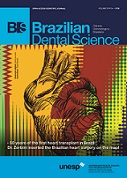Effect of different concentrations of nanohydroxyapatite on tooth bleaching effectiveness and enamel bond strength
DOI:
https://doi.org/10.14295/bds.2018.v21i1.1512Resumo
Objective: To evaluate the effect of 35% hydrogen peroxide (35% HP) combined to different concentrations of nanohydroxyapatite (nHA) on the effectiveness of dental bleaching (superficial enamel and deep dentin) and enamel bond strength. Material and Methods: Fifty bovine dental specimens (5x5x2mm) were divided into 5 groups, according to the treatments (n = 10): no bleaching (negative control); 35% HP (positive control); 35% HP+ 5% nHA; 35% HP + 10% nHa; and 35% HP + 15% nHA. Three in-office bleaching sessions were made. The color analysis was performed on the enamel surface and the opposite dentin, using a spectrophotometer. The results were expressed in the CIE L*a*b* system. After this, the adhesive system was applied to the tooth structure, and the dental specimens received a composite restoration. The microshear bond strength test was performed 24 h after the restoration. Data were submitted to ANOVA and Tukey's test (?=0.05). Results: For the enamel color analysis, all bleached groups differed statistically from the unbleached group, with increasing L* values and decreasing b* values. The addition of different concentrations of nHA did not interfere with the bleaching effectiveness for the enamel and opposite dentin. For microshear bond strength, no statistically significant differences were presented between groups. The adhesive failure rate of the 35% HP + 10% nHA group was lower than the 35% HP group and similar to the negative control. Conclusion: The addition of different concentrations of nHA in 35% of hydrogen peroxide did not interfere with the bleaching efficacy of enamel and deep dentin and did not affect the enamel bond strength after bleaching
Keywords
Enamel; Shear strength; Tooth bleaching.
Downloads
Downloads
Arquivos adicionais
Publicado
Como Citar
Edição
Seção
Licença
TRANSFERÊNCIA DE DIREITOS AUTORAIS E DECLARAÇÃO DE RESPONSABILIDADE
Toda a propriedade de direitos autorais do artigo "____________________________________________________________________" é transferido do autor(es) para a CIÊNCIA ODONTOLÓGICA BRASILEIRA, no caso do trabalho ser publicado. O artigo não foi publicado em outro lugar e não foi submetido simultaneamente para publicação em outra revista.
Vimos por meio deste, atestar que trabalho é original e não apresenta dados manipulados, fraude ou plágio. Fizemos contribuição científica significativa para o estudo e estamos cientes dos dados apresentados e de acordo com a versão final do artigo. Assumimos total responsabilidade pelos aspectos éticos do estudo.
Este texto deve ser impresso e assinado por todos os autores. A versão digitalizada deverá ser apresentada como arquivo suplementar durante o processo de submissão.




























